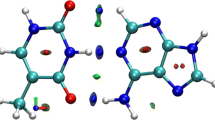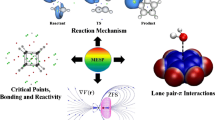Abstract
The visualization of covalent interactions has been a common practice in theoretical chemistry thanks to the electron localization function (ELF). More recently, the reduced density gradient (RDG) has been introduced as a tool for revealing non-covalent interactions. Along reactions, interactions change from weak to strong and vice versa. Thus, a tool enabling to analyze all of them simultaneously is fundamental for reactivity studies. This contribution is aimed at filling this gap within the NCI approach. We will highlight the ability of RDG to reveal also strong interactions and produce a benchmark that covers covalent, ionic and charge-shift bonds. The ability of the NCI descriptor to differentiate among them will be highlighted.






Similar content being viewed by others
References
Perdew JP, Burke K, Ernzerhof M (1996) Phys Rev Lett 77(18):3865
del Campo JM, Gázquez JL, Alvarez-Mendez RJ, Vela A (2012) Int J Quantum Chem 112(22):3594
Zupan A, Perdew JP, Burke K, Causa M (1997) Int J Quantum Chem 61(5):835
Schmider H, Sagar RP, Smith VH Jr (1992) Can J Chem 70(2):506
Kohout M, Savin A, Preuss H (1991) J Chem Phys 95(3):1928
Finzel K, Grin Y, Kohout M (2012) Theor Chem Acc 131(2):1
Kohout M, Pernal K, Wagner FR, Grin Y (2004) Theor Chem Acc: Theory, Comput, Model 112(5):453
Kohout M, Pernal K, Wagner F, Grin Y (2005) Theor Chem Acc: Theory, Comput, Model 113(5):287
Kohout M, Wagner F, Grin Y (2008) Theor Chem Acc: Theory, Comput, Model 119(5):413
Johnson ER, Keinan S, Mori-Sanchez P, Contreras-Garcia J, Cohen AJ, Yang W (2010) J Am Chem Soc 132(18):6498
Bohórquez HJ, Boyd RJ (2010) Theor Chem Acc 127(4):393
Bohórquez HJ, Matta CF, Boyd RJ (2010) Int J Quantum Chem 110(13):2418
De Silva P, Corminboeuf C (2014) J Chem Theory Comput 10(9):3745
Boto RA, Contreras-García J, Tierny J, Piquemal JP (2015) Mol Phys 1–9
Cedillo A, Robles J, Gázquez JL (1988) Phys Rev A 38(4):1697
Tal Y, Bader R (1978) Int J Quantum Chem 14(S12):153
Bader RF (1990) Atoms in molecules Wiley Online Library
Pendás AM, Francisco E, Blanco MA, Gatti C (2007) Chem A Eur J 13(33):9362
Hunter G (1986) Int J Quantum Chem 29(2):197
Kohout M (2016) Mol Phys 114(7–8):1297
Frisch MJ, Trucks GW, Schlegel HB, Scuseria GE, Robb MA, Cheeseman JR, Scalmani G, Barone V, Mennucci B, Petersson GA, Nakatsuji H, Caricato M, Li X, Hratchian HP, Izmaylov AF, Bloino J, Zheng G, Sonnenberg JL, Hada M, Ehara M, Toyota K, Fukuda R, Hasegawa J, Ishida M, Nakajima T, Honda Y, Kitao O, Nakai H, Vreven T, Montgomery JA Jr, Peralta JE, Ogliaro F, Bearpark M, Heyd JJ, Brothers E, Kudin KN, Staroverov VN, Kobayashi R, Normand J, Raghavachari K, Rendell A, Burant JC, Iyengar SS, Tomasi J, Cossi M, Rega N, Millam JM, Klene M, Knox JE, Cross JB, Bakken V, Adamo C, Jaramillo J, Gomperts R, Stratmann RE, Yazyev O, Austin AJ, Cammi R, Pomelli C, Ochterski JW, Martin RL, Morokuma K, Zakrzewski VG, Voth GA, Salvador P, Dannenberg JJ, Dapprich S, Daniels AD, Farkas, Foresman JB, Ortiz JV, Cioslowski J, Fox DJ (2009) Gaussian09 Revision E.01. Gaussian Inc. Wallingford CT
Schmidt MW, Baldridge KK, Boatz JA, Elbert ST, Gordon MS, Jensen JH, Koseki S, Matsunaga N, Nguyen KA, Su S et al (1993) J Comput Chem 14(11):1347
Ahrens J, Geveci B, Law C, Hansen C, Johnson C (2005) 36-paraview: an end-user tool for large-data visualization
Humphrey W, Dalke A, Schulten K (1996) J Mol Gr 14(1):33
Fischer A, Tiana D, Scherer W, Batke K, Eickerling G, Svendsen H, Bindzus N, Iversen BB (2011) J Phys Chem A 115(45):13061
Becke AD, Edgecombe KE (1990) J Chem Phys 92:5397
Reinhardt P, Hoggan PE (2009) Int J Quantum Chem 109(14):3191
Contreras-García J, Calatayud M, Piquemal JP, Recio J (2012) Comput Theor Chem 998:193
Llusar R, Beltrán A, Andrés J, Noury S, Silvi B (1999) J Comput Chem 20(14):1517
Shaik S, Danovich D, Silvi B, Lauvergnat DL, Hiberty PC (2005) Chem A Eur J 11(21):6358
Shaik S, Maitre P, Sini G, Hiberty PC (1992) J Am Chem Soc 114(20):7861
Wu W, Gu J, Song J, Shaik S, Hiberty PC (2009) Angewandte Chemie 121(8):1435
Gershoni-Poranne R, Chen P (2017) Chem A Eur J 23(19):4659
Wagner K, Kohout M (2011) Theor Chem Acc 128(1):39
Contreras-Garcia J, Yang W. Chemical concepts from density functional theory (Acta Physico-Chimica Sinica.), chap. The chemical information in Jacob’s ladder. (To be submitted)
Gillet N, Chaudret R, Contreras-Garc\(\acute{\iota }\)a J, Yang W, Silvi B, Piquemal JP (2012) J Chem Theory Comput 8(11):3993
Fang D, Chaudret R, Piquemal JP, Cisneros GA (2013) J Chem Theory Comput 9(5):2156
Andrés J, Berski S, Contreras-García J, González-Navarrete P (2014) J Phys Chem A 118(9):1663
Armstrong A, Boto RA, Dingwall P, Contreras-Garcia J, Harvey MJ, Mason NJ, Rzepa HS (2014) Chem Sci 5(5):2057
Acknowledgements
We are grateful to the reviewers of our paper for their careful reading and helping to improve this manuscript. This work was supported partially by the framework of CALSIMLAB under the public grant ANR-11-LABX-0037-01 overseen by the French National Research Agency (ANR) as part of the “Investissements d’Avenir” program (reference: ANR-11-IDEX-0004-02).
Author information
Authors and Affiliations
Corresponding author
Additional information
Published as part of the special collection of articles "First European Symposium on Chemical Bonding".
Appendix: Critical points of s
Appendix: Critical points of s
We now develop the gradient of s to shed some chemical insight into the critical points of s. CPs of s are given by the following equation:
where \(x_i\) stands for \(\{x,y,z\}\), \({\mathbf {u_{i}}}\) for three unit vectors along directions x, y and z, and \(H_{ij}\) for the electron density Hessian matrix elements \(\frac{\partial ^2\rho }{\partial x_{i}x_{j}}\). Since at CPs of s \(\nabla s\) must be zero along each direction x, y and z, the following three equalities must be satisfied:
To connect CPs of s with those of the electron density and with the Laplacian of the electron density, we shall consider different cases:
- Case 1. :
-
AIM-CPs: \(\frac{\partial \rho }{\partial x_{i}}=0\) for all i. \(|\nabla \rho |\) and \(\frac{\partial \rho }{\partial x_{i}}\) are equal to zero along each direction. Thus, there is a division 0/0 for each left-hand side of Eqs. 10, 11, and 12. Since \(\frac{\partial \rho }{\partial x_{i}}\) approaches to zero faster than \(|\nabla \rho |\) , this limit is zero along each direction. Therefore, at critical points of \(\rho\), \(\nabla s\) tends to zero.
- Case 2. :
-
Non-AIM-CPs: \(|\nabla \rho | \ne 0\),
$$\begin{aligned} \Big [H_{11} + H_{12} + H_{13} \Big ] \Big (\frac{\partial \rho }{\partial x}\Big )= & {} \frac{4}{3} \frac{|\nabla \rho |^2}{\rho } \Big (\frac{\partial \rho }{\partial x}\Big ), \end{aligned}$$(13)$$\begin{aligned} \Big [H_{21} + H_{22} + H_{23} \Big ] \Big (\frac{\partial \rho }{\partial y}\Big )= & {} \frac{4}{3} \frac{|\nabla \rho |^2}{\rho } \Big (\frac{\partial \rho }{\partial y}\Big ), \end{aligned}$$(14)$$\begin{aligned} \Big [H_{31} + H_{32} + H_{33} \Big ] \Big (\frac{\partial \rho }{\partial z}\Big )= & {} \frac{4}{3} \frac{|\nabla \rho |^2}{\rho } \Big (\frac{\partial \rho }{\partial z}\Big ). \end{aligned}$$(15)- Case 2.1. :
-
\(\frac{\partial \rho }{\partial x_{i}} \ne 0\) for all i
$$\begin{aligned} H_{11} + H_{12} + H_{13}= & {} \frac{4}{3} \frac{|\nabla \rho |^2}{\rho }, \end{aligned}$$(16)$$\begin{aligned} H_{21} + H_{22} + H_{23}= & {} \frac{4}{3} \frac{|\nabla \rho |^2}{\rho }, \end{aligned}$$(17)$$\begin{aligned} H_{31} + H_{32} + H_{33}= & {} \frac{4}{3} \frac{|\nabla \rho |^2}{\rho } . \end{aligned}$$(18).
- Case 2.2. :
-
Mutual cancelation of all off-diagonal terms: \(H_{12} + H_{13}= H_{21} + H_{23} = H_{31} + H_{32} = 0\)
$$\begin{aligned} H_{11} = H_{22} = H_{33} = \frac{4}{3} \frac{|\nabla \rho |^2}{\rho }. \end{aligned}$$(19)It is worth noting that the trace of H, \(H_{11} + H_{22} + H_{33}\), which is equal to the Laplacian of the electron density, \(\nabla ^{2} \rho\), takes positive values and equal to \(4 \frac{|\nabla \rho |^2}{\rho }\).
- Case 2.3. :
-
H is diagonal. Then, all off-diagonal terms are zero and Equality 19 is obtained.
Rights and permissions
About this article
Cite this article
Boto, R.A., Piquemal, JP. & Contreras-García, J. Revealing strong interactions with the reduced density gradient: a benchmark for covalent, ionic and charge-shift bonds. Theor Chem Acc 136, 139 (2017). https://doi.org/10.1007/s00214-017-2169-9
Received:
Accepted:
Published:
DOI: https://doi.org/10.1007/s00214-017-2169-9




